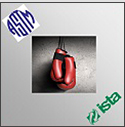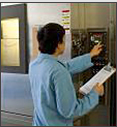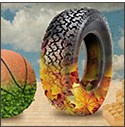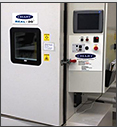 |
| |
| Sponsored by Westpak Inc. |
| |
|
|
| |
| SPONSOR MESSAGE |
| |
 |
Package Testing Webinar: ASTM vs. ISTA
WESTPAK’s ISO 17025-accredited test laboratory presents "ASTM vs. ISTA for Package Testing — Which Is Better?" as a |
|
| free webinar with live Q&A on June 14, or later as On-Demand. A comparison between the ISTA 1-3 Series protocol vs. the correlating ASTM standard is made. Includes actual situations where medical device teams were challenged with specifying test protocols for their products. |
| |
| Watch Webinar » |
| |
|
|
| |
| |
| |
 |
| Next-Generation Heart Valve Regenerates into Heart-Like Tissue |
| Wyss Institute developed a nanofiber fabrication technique to manufacture heart valves with regenerative potential. The valve-shaped nanofiber network mimics native valve extracellular matrix (ECM) properties. A rotating nozzle extrudes an ECM solution into nanofibers that wrap themselves around heart valve-shaped mandrels — like a fast cotton candy machine. |
| |
| Learn more » |
|
|
| |
| |
| |
| |
|
|
| |
|
SPONSOR MESSAGE |
| |
|
|
| |
 |
| Accelerated Aging Time (AAT) Calculator |
| One of the most called-upon and useful tools in WESTPAK's tool kit is the Accelerated Aging Time Calculator. The formula is based on Arrhenius' equation and employed to determine the Accelerated Aging Time (AAT) for any Accelerated Aging Temperature (AAT). It's a useful tool to perform what-if scenarios on test alternatives at various AATs. WESTPAK has dedicated accelerated aging chambers set at +50°C, +55°C, and +60°C. |
| |
| Learn more » |
| |
|
|
| |
| |
| |
 |
| Laser Printing With Nanoparticles Holds Promise for Medical Research |
| Electronic devices that not only can be implanted in the human body but also completely dissolve on their own – known as bioresorbable electronics – are regarded as one of medical technology’s next frontiers. A study suggests that a laser printing technique using nanoparticles could help unlock a more cost-effective approach to building sturdier, safer components. |
| |
| Learn more » |
|
|
| |
| |
| |
| |
|
|
| |
|
SPONSOR MESSAGE |
| |
|
|
| |
 |
| Whitepaper: Why Shipping Tests Don't Work |
| "Shipping tests" or "trial shipments" are often used to see if a product or protective package will survive the distribution environment without damage. While one "shipping test" would be statistically insignificant, conducting 30+ shipments as trial might be impractical and costly. WESTPAK's brief paper investigates the reasons and recommends a more feasible approach: conduct testing in a controlled, repeatable, laboratory environment. |
| |
| Learn more » |
| |
|
|
| |
| |
| |
 |
| Process Invented to Make Sustainable Rubber and Plastics |
| Synthetic rubber and plastics used for manufacturing tires, toys, and myriad other products are produced from butadiene, a molecule traditionally made from petroleum or natural gas. But those humanmade materials could get a lot greener soon, thanks to scientists who have invented a process to make butadiene from renewable sources. |
| |
| Learn more » |
|
|
| |
| |
| |
| |
|
|
| |
|
SPONSOR MESSAGE |
| |
|
|
| |
 |
| HALT and HASS Testing Service |
| Highly Accelerated Life Testing (HALT) and Highly Accelerated Stress Screening (HASS) are valuable reliability techniques. A HALT/HASS machine is a specialized environmental chamber with the ability to combine temperature and random vibration inputs simultaneously which in turn provides relatively fast test results. WESTPAK's chamber has been used in studies to improve product robustness, useful lifespan, and component screening. |
| |
| Learn more » |
| |
|
|
| |
| |
| |
 |
| UV Light Sensor for Wearable Devices in IoT Era |
| Measurement of UV light using a smartphone or wearable device could be of great benefit to the healthcare and aesthetic medicine communities in their attempts to prevent sunburns and skin blemishes. To that end, mass production technology for silicon-based UV light sensors, suitable for smartphones and wearable devices in the IoT era, has been developed. |
| |
| Learn more » |
|
|
| |
| |
| |








